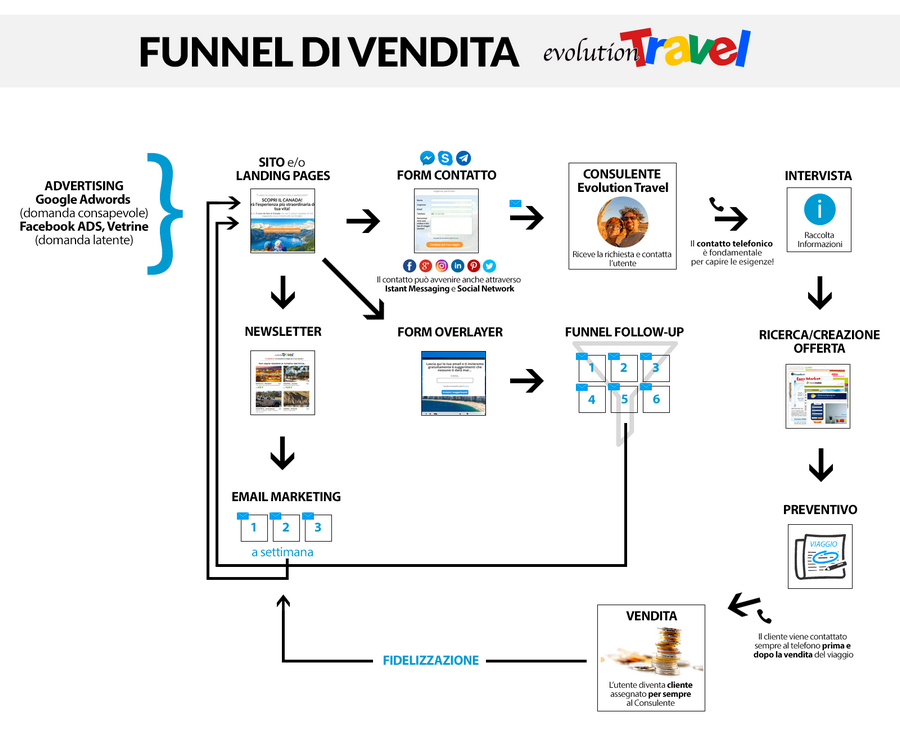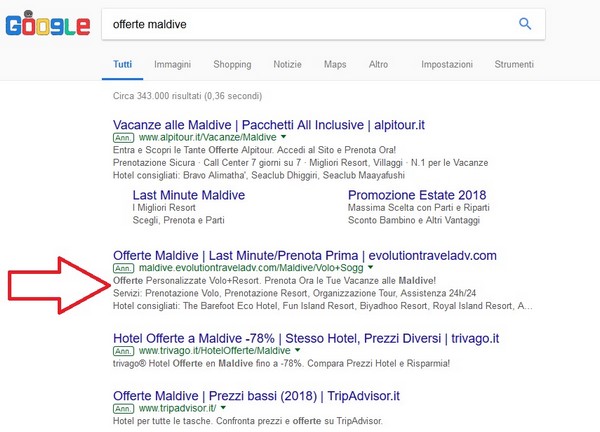Today we are analysing the sales funnel of Evolution Travel, step by step.
What is meant by “funnel”? How can an online travel advisor come into contact with potential clients and follow them until the positive conclusion of the sale?
The funnel describes the route taken by a user, from the moment in which they “discover” Evolution Travel online until the moment when the sale takes place.
It is, therefore, the set of actions that a person takes before effectively becoming a client.
The most frequently-used image to explain this is that of a funnel: the entrance is very large, while the exit is very narrow.
This means that contacts can be numerous but not all of them will book a holiday.
So what steps can be taken to positively conclude a travel deal?
We are about to find out…
Unlike that of its competitors, the Evolution Travel model is not based on a list of personal contacts and the wider circle of friends and family.
Instead, everything is concentrated on attentive marketing activities that allow the consultant to acquire clients and accompany them in the sale.
Selling holidays online allows us to have a potentially huge market: as there are no geographical restrictions, clients can live and contact us from anywhere in the world.
So how can we find people who want to travel? What leads a person to trust an online travel advisor?
The mechanism for acquiring new clients follows several phases:
- Attenuation of marketing strategies
- Contact, telephone call: create a rapport
- The sale
- Loyalty marketing
It is important to work out a simple route whereby the user can “travel” towards the point of acquisition, using all the communication means that the web offers us.
So let’s move on to analyse, step by step, the sales funnel, i.e. the route that leads from the desire (either expressed or latent) of a potential client to an actual booking and departure.
Google Adwords and Facebook Ads: the 2 main strategic channels for Evolution Travel’s marketing
It all starts with the user’s desire to go on holiday. It is in this moment, therefore, that the marketing resources are activated to welcome the internet user into our funnel.
We place ourselves at their disposal, beginning to propose our advertising announcements immediately.
Mario Rossi is at home: he looks out the window and sees snowflakes falling. He can’t take any more of winter and the cold! He has a dozen holiday days remaining and so decides that he wants to set off for a warmer destination. He switches on his PC and searches for “Maldives offers” on Google.
Mario has expressed a conscious desire and has immediately set about looking for a solution to his holiday need.
Evolution Travel responds with an advertising announcement via Google Adwords (see next photo) and when he clicks on us, he begins his journey towards the pages of Evolution Travel.
Not all users have such clear ideas as Mario Rossi.
There is Giovanni Verdi, for example, who, like Mario, is saddened by the bad weather and – bored – he opens Facebook and scans his timeline lazily.
Suddenly he sees a sponsored post: it is a travel offer for Cuba from Evolution Travel.
Giovanni brightens up, and thinks that this would be a great chance to seize the moment: he has remaining holiday, a sufficient budget and plenty of desire to take a holiday somewhere special… And all this without knowing where he wanted to go just a few minutes before!
Facebook ADS thus allows us to identify target users who would be suited to the product that we are offering, thanks to an incredibly powerful and precise profiling system. In this case, a latent desire – i.e. the wish to travel without having already decided where he wanted to go, for example – has been stimulated.
One advertising strategy does not exclude the other; indeed, they can actually strengthen each other.
Simultaneous matching is successful because the client, noticing Evolution Travel’s offers on various channels (i.e. on search engines and social networks), recognises the brand and thus acquires more confidence.
In some cases, clicking on one of the announcements, the client will reach a site or landing page. At this point, he/she can leave their details for various purposes:
- To subscribe to the newsletter
- To obtain a series of informative emails focusing on the destination they are interested in
- To request contact from an online travel advisor.
1) The Evolution Travel newsletter: offers, useful information, engaging content that will always hold clients’ attention
When the user subscribes to the newsletter they will begin to regularly receive the newsletter of offers that Evolution Travel prepares from 2-3 times every week.
Offers of the moment, travel suggestions, unbeatable deals, details etc…
Clicking on the offer that interests them, they will reach one of the information pages present on the website of the advisor. This allows for the optimisation of the conversion rate of an advertising campaign and the cost of acquisition of a client, because the user who does not immediately enter into contact with the adviser can also do so at a later time, precisely because they have requested the newsletter.
2) “Follow up”: travel tidbits that accompany the user towards contact with the advisor
If the client is not yet ready to enter into contact with an advisor, they can decide to leave their email address in order to receive special information on the place that they dream of visiting, directly into their inbox. This is not about offers, as in the point above regarding the newsletter, but rather informative texts written for him/her: these are travel secrets and curiosities prepared by our destination or product specialists.
The user, receiving this content day after day, which has been tailored to him/her, feels ever closer to their trip; their desire grows and, at the same time, they perceive the expertise and knowledge of the specialist who is providing this content, strengthening their inclination to get in touch.
3) Speaking with the travel advisor right away makes all the difference!
In the vast majority of cases, the client wishes to receive qualified advice and a quote.
In these circumstances, it suffices for the client to leave their data in a designated contact form or via social networks or even via instant messaging apps (such as Messenger, WhatsApp, Telegram or Skype). Within a very short time, the client will receive a phone call from an online travel advisor.
Every client, based on their schedule and preferences, can therefore decide to “meet” their online travel advisor for the first time.
There are people who prefer a quick relationship, with only short periods between their request for information and receiving a response. In these cases, apps such as WhatsApp and Telegram are preferable: a large number of advisors have exploited the possibility of searching for clients via these channels, remaining available at all times and responding to requests in real time. Other clients, however, prefer “traditional” contact via email or telephone, without the urgency of immediate feedback.
The first telephone call: you only have a few seconds to capture the client’s attention
Telephone contact with the client is fundamental; the importance of this client approach can’t be underestimated. A successful telephone call, i.e. one which is truly based on listening attentively to the person who has turned to you, is everything: only through concentrating on the needs of that person can you tailor the best travel experience possible for him/her.
Completely understanding the needs of the client is vital, in order to effectively offer that person what they want.
At the same time, it is important to understand immediately whether the client’s travel idea is suitable for the expressed request.
This depends a lot on the knowledge of the advisor who, if well informed, will immediately understand whether there are “minimum requirements” to accommodate the desire of the client.
Is the budget sufficient? Is the time of year right for a specific destination? Are there specific requirements? etc…
Ask the right questions and listen with attention to the response of the potential client: only thus is it possible to gather all the necessary information to produce a refined offer that is most in line with the client’s expectation.
The sartorial task of creating a personalised holiday
Once all the useful information has been obtained, a new phase begins: the search for – or creation of – a holiday offer for the client. “Personalising”: this is more than a requirement. It is a mission, to “sew onto” the holidaymaker the best possible experience for them, with regards to the desires expressed – including latent desires, budget requirements and time constraints. Only through operating in this way is it possible to reach the primary aim: that of satisfying the travel desires of the client.
This is a fundamental point, as the user will become a client who is FOREVER entrusted to the Evolution Travel online travel advisor. A lasting relationship will be created, which will prompt the holidaymaker to return back to the same Evolution Travel advisor.
Once the quote has been created, it is down to the advisor to offer it to the potential client in the best way possible, perhaps communicating it via telephone before sending it by email.
The sale: is it just a question of price?
Evolution Travel’s 18 years of experience allow us to affirm that booking, on the part of the client, does not just depend on price but is rather determined by the whole process followed together with the client.
Rapport, the ability to manage the client’s requests, an urgent commitment to offering the very best, attention to details and time to dedicate for telephone calls are the elements that far outweigh price in terms of importance. At this point, having worked well and with conscientiousness, sale is concluded with the client’s confirmation and with payment of the holiday proposed.
The end of the funnel is the start of the relationship with the client: loyalty marketing
The job is not over yet: upon return, it is always advisable to call the client to find out how their experience went. Receiving their feedback is important because, as already noted, we will be dealing with the client again in the future.
It is therefore interesting to understand if what was planned for the client successfully satisfied his/her tastes, so that we can do even better on future occasions.
The advisor can periodically get in touch with the client, at this point approaching them with entirely personalised “one to one” messages (because the advisor is now known and familiar with the kind of holidaymaker they are dealing with), to offer their services again.
Furthermore, the client receives a feedback request via email. Their words will be published online and this naturally generates trust in other users who are potentially interested in travelling.
Thanks to this, then, other people will enter the funnel.
Succeeding in sketching out a brief and simple funnel helps to “accompany” the client up to the point of sale, without “losing” him or her. The marketing department takes care of this every day.
It is fundamental that the advisor knows these steps, because internalising them will allow them to work better.
Knowing that the name you receive is the fruit of a series of important steps ensures that much importance is given to what lies within their expertise. Focus, therefore, on attentive listening, on the right time to dedicate to the telephone call, and on the correct choice of holiday solution for that person.
The advisor is a fundamental part of the process: knowing the funnel means optimising the process and satisfying the client – without forgetting to “embrace them” upon re-entry.
By Stefania Bochicchio




Leave a Reply